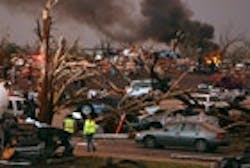EPA: Air Monitoring Results Posted on Joplin Tornado Site
EPA Region 7 officials are sharing online results of its ongoing air monitoring activities at the tornado impact zone in Joplin, Mo. The data from Region 7’s air sampling for asbestos and particulate matter, which began May 28, has not indicated any health-related concerns so far.
As additional data is collected and analyzed, EPA officials will post those results on the Joplin tornado website, which also contains fact sheets, health and safety information, and other materials related to the Agency’s response to the May 22 tornado.
As one of its missions assigned by the Federal Emergency Management Agency (FEMA), EPA developed a plan to conduct air monitoring to protect public health as the recovery efforts in Joplin continue. That plan includes sampling the air at various locations in and around the tornado’s impact zone, with an emphasis on monitoring for asbestos and particulate matter.
At most tornado sites, asbestos fibers are normally not found at levels of health concern. However, because of the age of many structures and the extent of tornado damage in Joplin, asbestos may be present among the debris and could be released. Handling debris can cause particles to get into the air where they can be breathed. Exposure to asbestos can cause serious lung problems and cancer.
Particulate matter, also known as particle pollution, in the air includes a mixture of solids and liquid droplets from a potentially wide range of sources. Some particles are emitted directly; others are formed in the atmosphere when other pollutants react. Particles come in a wide range of sizes. Some particles are so small that they can get into the lungs, causing health problems, especially for people with pre-existing respiratory conditions such as asthma, emphysema or chronic obstructive pulmonary disease.
To minimize exposure to asbestos fibers and particulate matter in the impact zone, EPA recommends that persons use NIOSH-approved N-100, P-100 or R-100 respirators. If worn improperly, respirators may provide little or no protection. Instructions for proper use of a respirator must be followed carefully and closely.
EPA’s air sampling will be adjusted as conditions warrant change. The amount of demolition and debris removal or burning, the results of air sampling, and other factors may result in changes to EPA’s plan.
Source: EPA
